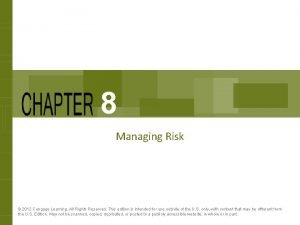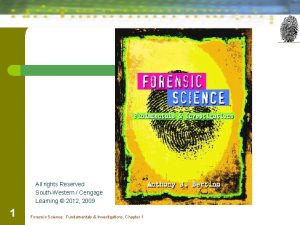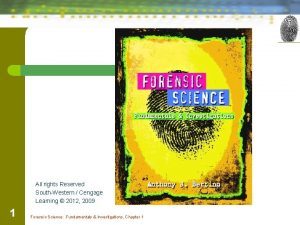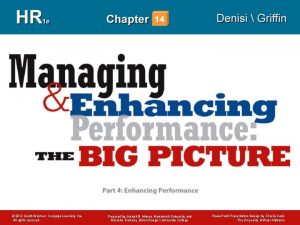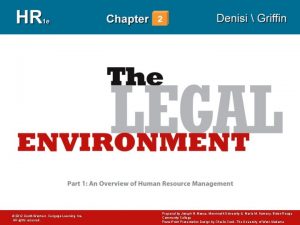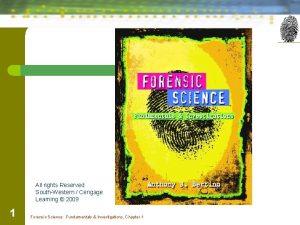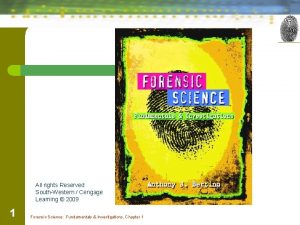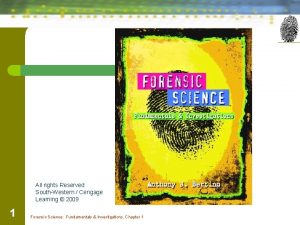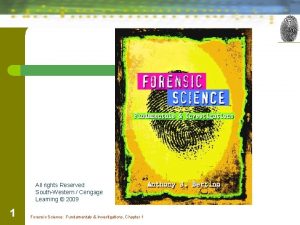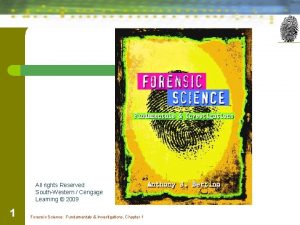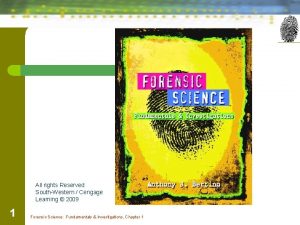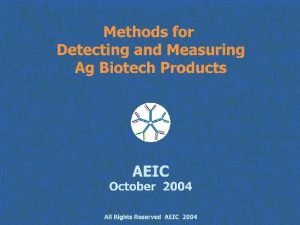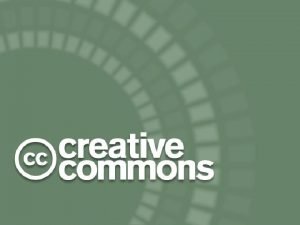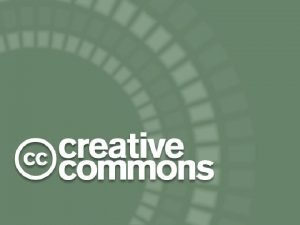x All rights Reserved SouthWestern Cengage Learning 2012



















- Slides: 19

x All rights Reserved South-Western / Cengage Learning © 2012, 2009 1 Forensic Science: Fundamentals & Investigations, Chapter 1

Chapter 1 Observation Skills By the end of this chapter you will be able to: o o o 2 Define observation and describe what changes occur in the brain Describe examples of factors influencing eyewitness accounts of events Compare the reliability of eyewitness testimony with what actually happened Forensic Science: Fundamentals & Investigations, Chapter 1

Chapter 1 Observation Skills By the end of this chapter you will be able to: o o o 3 Relate observation skills to their use in forensic science Define forensic science Practice and improve your observation skills Forensic Science: Fundamentals & Investigations, Chapter 1

4 Forensic Science: Fundamentals & Investigations, Chapter 1

Introduction The forensic examiner must be able to 1. find—identify the evidence 2. document—record the evidence 3. interpret—accurately determine the significance of the evidence 5 Forensic Science: Fundamentals & Investigations, Chapter 1

What Is Observation? Our brains can filter out information. Point out some of the details in this photo. 6 Forensic Science: Fundamentals & Investigations, Chapter 1

What Is Observation? How information is processed in the brain 7 Forensic Science: Fundamentals & Investigations, Chapter 1

What Is Observation? Our brains fill in gaps in our perception o In order to make sense of what we perceive, our brains often enrich with detail what we see, taste, hear, smell, or feel o After an event, we can believe things were part of the background even though they were not 8 Forensic Science: Fundamentals & Investigations, Chapter 1

What Is Observation? Our brains apply previous knowledge to new situations 9 What assumptions can you make about this scene? How might those assumptions be wrong? Forensic Science: Fundamentals & Investigations, Chapter 1

Observations by Witnesses Observations are affected by: o o o 10 Their emotional states Whether they were alone, part of a group, or near others What type of and how much activity was going on around them Forensic Science: Fundamentals & Investigations, Chapter 1

Eyewitness Accounts o Crime-scene reports often vary, due to: • • 11 level of interest stress concentration amount and kind of distractions present prejudices personal beliefs motives any lapse in time since the event Forensic Science: Fundamentals & Investigations, Chapter 1

The Innocence Project o o o 12 Barry C. Scheck and Peter J. Neufeld Benjamin N. Cardozo School of Law, Beginning in 1992, used DNA to examine post-conviction cases Faulty eyewitness identifications accounted for up to 87% of the wrongful convictions Forensic Science: Fundamentals & Investigations, Chapter 1

How to be a Good Observer Observe systematically o o o 13 Start at one part of a crime scene and run your eyes slowly over every space Look carefully at details of each piece of evidence Do not assume you will remember everything Forensic Science: Fundamentals & Investigations, Chapter 1

How to be a Good Observer Turn off filters o o o 14 Consciously pay attention to all details Do not pay attention to just what you think is important All details are potentially important Forensic Science: Fundamentals & Investigations, Chapter 1

How to be a Good Observer Collect Information first, interpret data later o o o Look for patterns and make connections More information yields better interpretations Prejudices exist everywhere— • eyewitness accounts • your own thinking processes 15 Forensic Science: Fundamentals & Investigations, Chapter 1

How to be a Good Observer Documentation, Documentation o o o 16 Write down and photograph as much information as possible Be aware that memory is faulty Remember that our brains tend to fill in gaps in our perceptions Forensic Science: Fundamentals & Investigations, Chapter 1

Observations in Forensics o o o 17 Study situations Find clues in ordinary details Work backwards from the evidence to what led up to the crime Be patient Practice Forensic Science: Fundamentals & Investigations, Chapter 1

. . . Summary. . o o o 18 The environment and our natural sensory filters affect our ability to observe Eyewitness reports can be correct, faulty, or a little of both Acquiring good observation skills takes practice and training Forensic Science: Fundamentals & Investigations, Chapter 1

. . . . Summary o Forensic scientists: • Find and Document Evidence • Evaluate and Interpret • Provide expert testimony to courts 19 Forensic Science: Fundamentals & Investigations, Chapter 1
 2012 cengage learning
2012 cengage learning All rights reserved example
All rights reserved example Copyright 2015 all rights reserved
Copyright 2015 all rights reserved All rights reserved sentence
All rights reserved sentence Creative commons vs all rights reserved
Creative commons vs all rights reserved Confidential all rights reserved
Confidential all rights reserved Sentinel repetition
Sentinel repetition Copyright 2015 all rights reserved
Copyright 2015 all rights reserved Pearson education inc all rights reserved
Pearson education inc all rights reserved Microsoft corporation. all rights reserved.
Microsoft corporation. all rights reserved. Microsoft corporation. all rights reserved
Microsoft corporation. all rights reserved Microsoft corporation. all rights reserved.
Microsoft corporation. all rights reserved. Pearson education inc. all rights reserved
Pearson education inc. all rights reserved Dell all rights reserved copyright 2009
Dell all rights reserved copyright 2009 Warning all rights reserved
Warning all rights reserved C all rights reserved
C all rights reserved Quadratic equation cengage
Quadratic equation cengage Warning all rights reserved
Warning all rights reserved Confidential all rights reserved
Confidential all rights reserved Microsoft corporation. all rights reserved
Microsoft corporation. all rights reserved
